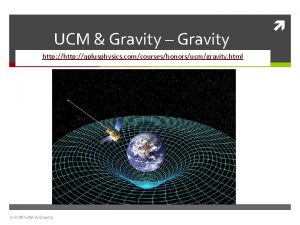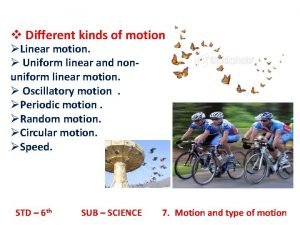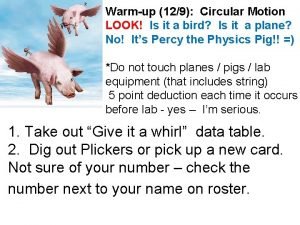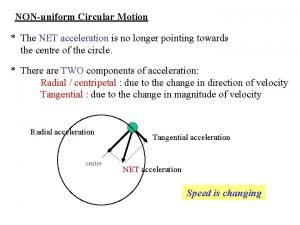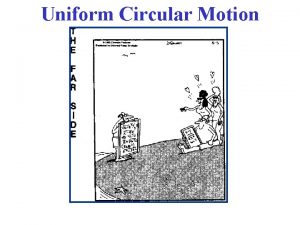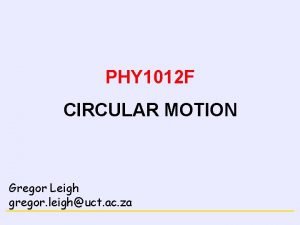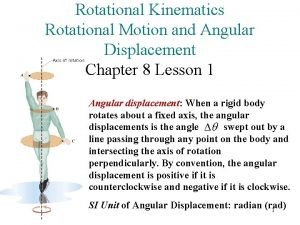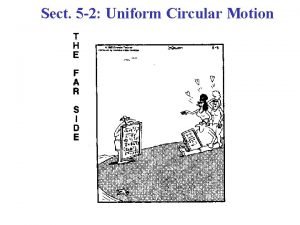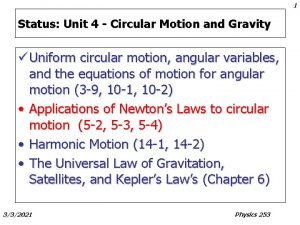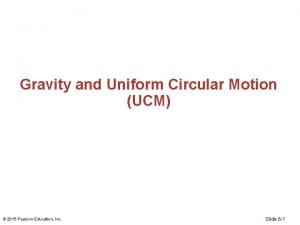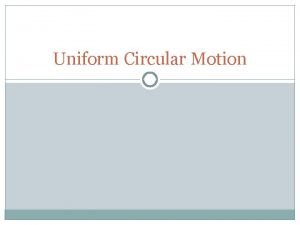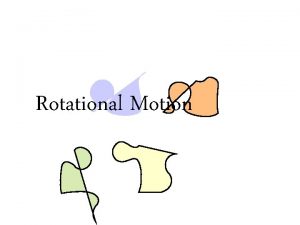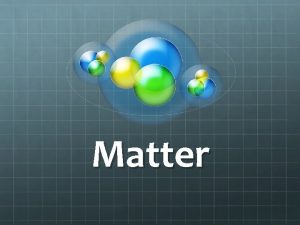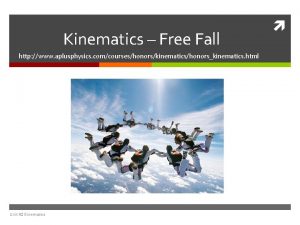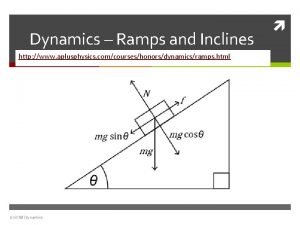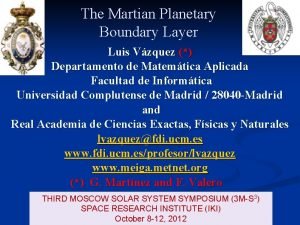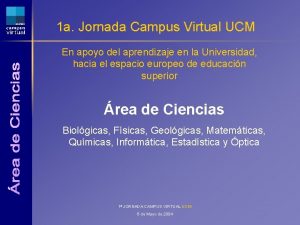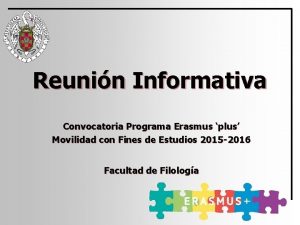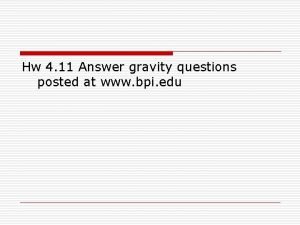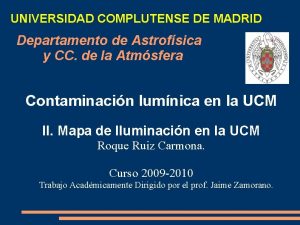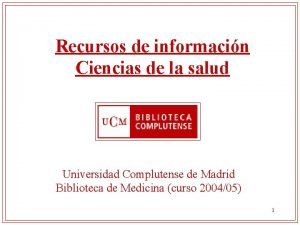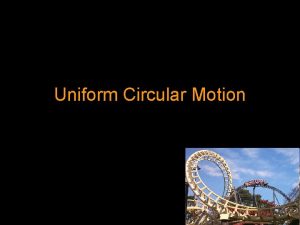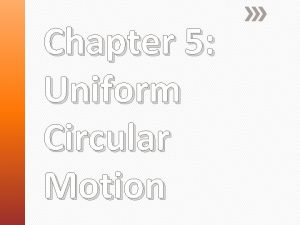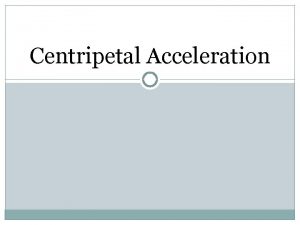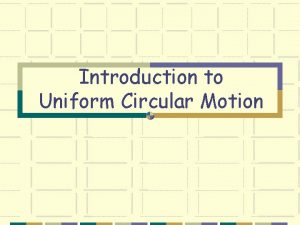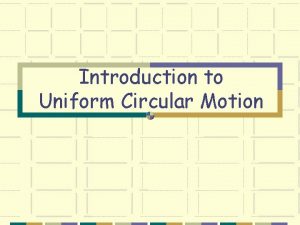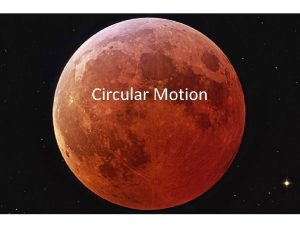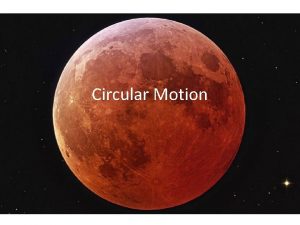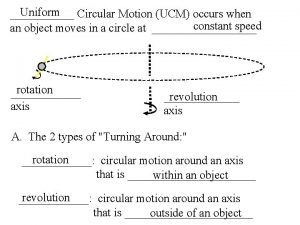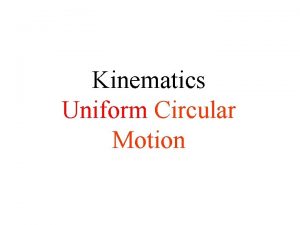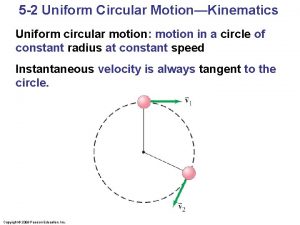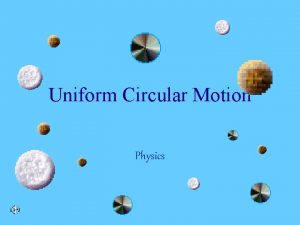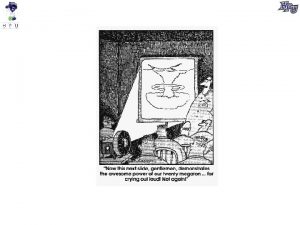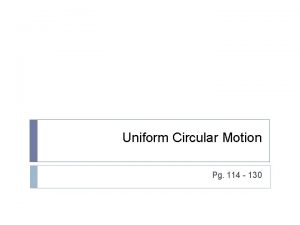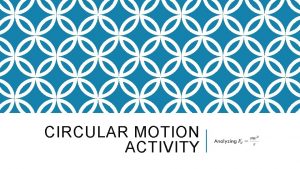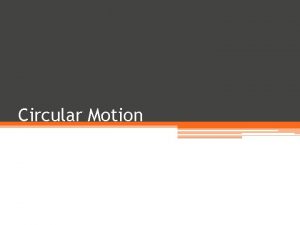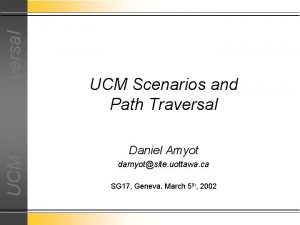Circular Motion Uniform Circular Motion UCM Uniform circular





































- Slides: 37

Circular Motion

Uniform Circular Motion- UCM Uniform circular motion can be described as the motion of an object in a circle at a constant speed. Remember what vectors represent…magnitude and direction. As an object moves around in a circle the magnitude of it’s velocity remains constant but the direction changes. This means it’s velocity is in fact changing. A change in velocity means there is an acceleration.

Centripetal Acceleration r An object moving uniformly in a circular path always has a centripetal acceleration. This acceleration is always directed toward the center of the circle. ac = v 2 r

A 900 -kg car moving at 10 m/s takes a turn around a circle with a radius of 25 m. Determine the acceleration of the car. Does the mass of the car matter? ac = v 2 r ac = (10 m/s)2 25 m ac = 100 m 2/s 2 25 m ac = 4 m/s 2

If there’s an acceleration doesn’t that mean there must be a force? Remember Newton’s 2 nd? Applying an unbalanced force to a mass will cause it to accelerate. Fnet = ma The force causing an object to move in a circular motion is called the CENTRIPETAL FORCE (Fc). Fc is a vector that is directed towards the center of the circle and it produces centripetal acceleration. Fc = mac F = ma ac = v 2 r Fc = mv 2 r

A 900 -kg car moving at 10 m/s takes a turn around a circle with a radius of 25 m. Determine the centripetal force pulling the car. Does the mass of the car matter? Fc = mv 2 r Fc = 900 kg(10 m/s)2 25 m Fc = 3600 N

A few things to consider… There is NO force pulling the ball outward. The force of tension from the string is holding it in a circular path. The velocity vector is tangent to the circle. The velocity of the ball is in this direction but it is being force toward the center of the circle by the Fc (tension) forcing it to follow a curved path. Notice that the Fc vector is perpendicular to the velocity vector.

What if there was no force? The string breaks… Remember Newton’s 1 st…an object in motion will stay in motion Will the ball continue to follow the path of the circle? NO. There is no longer a force pulling it towards the center. It will follow the path of the velocity vector, which is tangent to the circle. The ball with continue on a straight path.

Shot put and hammer throwers use centripetal acceleration to gain speed then when they release the object it moves outward tangent to the circle.

If the centripetal force is ALWAYS directed inward then why do you get forced in the opposite direction during turns? This is caused again by Newton’s 1 st. It’s inertia. Your body is resisting the motion. This is often mistaken for a force- centrifugal force. Be careful this force is fictitious.

A car approaches a level circular curve with a radius of 300 m. If the concrete pavement is dry (µ =. 9), what is the maximum speed at which the car can negotiate the curve at a constant speed without slipping? The net force on a car traveling around a curve is the Fc and it is directed toward the center of the curve. The force of friction is the only horizontal force on a car and provides the centripetal force. ΣF statement: ΣF = mac FN Ff Ff Fg ΣF = Ff Ff = µFN mac= Ff v 2 µmg r mv 2 = µmg r ΣFy = 0 ΣFy = Ff - w Ff = w = mg

v=? mv 2 = µmg r rmv 2 = µmgr r mv 2 = µmgr m m So the mass of the car doesn’t matter. v 2 = µgr v 2 = (. 9)(10 m/s 2)(300 m) √v 2 = √ 2700 m 2/s 2 v = 52 m/s

Amusement parks have several rides that show this fictitious force. Ff FN Fg What forces are acting on these people? The normal force is going out of the wall is pushing back on them. There bodies resistance to the spinning motion (INERTIA) is what causes them to be pinned up against the wall.

Ff Ff FN How fast does the ride need to be spinning to keep you pinned against the wall? FN Fg ΣFx = mac ΣFy = 0 ΣFx = FN mac = FN v 2 r mg µ Fg Ff = µFN ΣFy = Ff - w FN = Ff µ Ff = w = mg mv 2 = mg r µ = mv 2 = mg mr mµ = r v 2 = gr r µ v 2 = gr µ

The centripetal force is what allows satellites to stay in orbit around the Earth. g = GM r 2 This centripetal force (Fc) is the gravitational force (Fg) of the Earth. Fc = g The velocity of the satellite would be directed tangent to the circle at every point along its path. The acceleration of the satellite would be directed towards the center of the Earth. Satellites are “falling in a circle” around the Earth.

The centripetal force is what allows the planets to stay in orbit around the Sun. Fg = Gm. M r 2 This centripetal force (Fc) is the gravitational attraction (Fg) of the planet-sun system. Fc = Fg The velocity of the planet would be directed tangent to the circle at every point along its orbit. The acceleration of a planet would be directed towards the center of the its orbit towards the sun.

Roller coasters- the feeling of weightlessness and heaviness This is similar to an elevator ride. We need to first look at the forces acting on the riders. The only forces exerted upon the riders are the force of gravity and the normal force (the force of the seat pushing up on the rider). The force of gravity is at all times directed downwards and the normal force is at all times directed perpendicular to the seat of the car.

FN FN Fg Fg BOTTOM OF LOOP FN is greater than Fg – feeling of heaviness TOP OF LOOP FN is less than Fg – feeling of weightlessness







The Earth revolves around the sun in a nearly circular orbit; it’s average distance from the Sun is about 1. 5 x 108 km. Find the speed at which the Earth orbits around the sun. Mass. Earth = 6. 0 x 1024 kg Mass. Sun = 2. 0 × 1030 kg ΣF = Fc ΣF = Fg Gravitational Force btw the Earth and the Sun Fc = F g mv 2 = Gm. M r r 2 rmv 2 = Gm. Mr = mv 2 = Gm. M = v 2 = GM r r r 2 rm m

= v 2 = GM r v 2 = 6. 67 x 10 -11 kg m 2/s 2 (2. 0 x 10 30 kg) 1. 5 x 1011 m v 2 = 8. 89 x 108 m 2/s 2 v = 29, 822 m/s










What is the minimum velocity needed to maintain a satellite’s circular orbit around the earth if it is located at a height of 500 km (500, 000 m) above the surface of the Earth. For satellites in circular orbits, the "acceleration due to gravity" supplies the necessary centripetal acceleration to maintain its orbit. The speed of a satellite in a circular orbit is constant

Determine the value of the centripetal force acting on the women flying the airplane when she is at the top of the loop. Does she feel lighter or heavier than normal at this position? Explain.
 Ucm-gravity
Ucm-gravity Type of motion
Type of motion Centripetal acceleration symbol
Centripetal acceleration symbol Net acceleration in circular motion
Net acceleration in circular motion How are uniform circular motion maps
How are uniform circular motion maps What is uniform circular motion
What is uniform circular motion Rtz coordinate system
Rtz coordinate system Si unit of angular velocity
Si unit of angular velocity Circular motion with constant speed
Circular motion with constant speed Circular motion
Circular motion Apparent weight formula
Apparent weight formula Uniform circular motion lab answer key
Uniform circular motion lab answer key How to calculate circular motion
How to calculate circular motion Dynamics of uniform circular motion
Dynamics of uniform circular motion Mixtures and solutions grade 7
Mixtures and solutions grade 7 How do you classify uniform and non-uniform mixtures?
How do you classify uniform and non-uniform mixtures? Aliran tak seragam
Aliran tak seragam Jckl library study rooms
Jckl library study rooms Catalogo cisne ucm
Catalogo cisne ucm Oracle ebs crm
Oracle ebs crm Aplusphysics: kinematics-free fall
Aplusphysics: kinematics-free fall Linguistcs
Linguistcs Ucm liferay
Ucm liferay Biblioteca farmacia ucm
Biblioteca farmacia ucm Refworks ucm
Refworks ucm Bucea ucm
Bucea ucm Biblioteca optica ucm
Biblioteca optica ucm Aplusphysics answer key
Aplusphysics answer key Facultad de ciencias físicas ucm
Facultad de ciencias físicas ucm Ucm campus virtual
Ucm campus virtual Erasmus plus ucm
Erasmus plus ucm Ucm gravity worksheet answer key
Ucm gravity worksheet answer key Uc merced bus schedule
Uc merced bus schedule Campus uhu
Campus uhu Paraninfo sur ucm
Paraninfo sur ucm Proc esm
Proc esm Les dossiers clients
Les dossiers clients Cinahl ucm
Cinahl ucm
